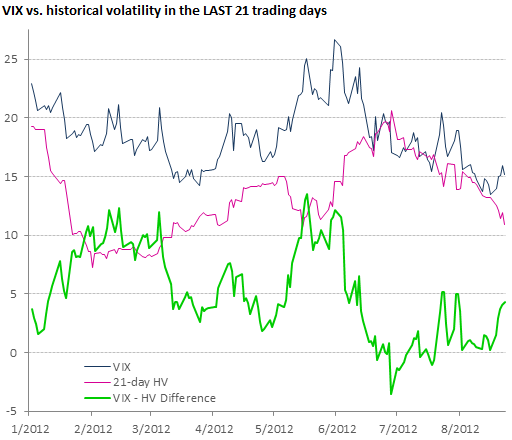Historical Volatility In Options
Post on: 17 Октябрь, 2015 No Comment

A guide to understanding historical volatility when trading options.
What is Historical Volatility?
Option traders should stay mindful of two kinds of volatility in options trading: historical and implied volatility. These factors can be crucial to successfully trading options online.
As the name implies, historical volatility deals with what has actually passed. Formally speaking, historical volatility is the annualized standard deviation of past underlying price moves. It measures the daily price changes in the underlying over the past year. (An underlying can be a stock, futures contract, or index.)
There’s another kind of volatility measure that deals not with the past, but with the future — that’s called implied volatility. In contrast, implied volatility (IV) derives from an option’s price; it tells what the market implies the underlying instrument’s volatility will be in the future.
Implied Volatility is one of six variables in the options-pricing formula, and the only one that’s not directly observable in the market. However, it acts as a key surrogate for option value — higher IV usually translates to higher option premiums.
It’s tempting to focus on historical volatility. After all, it’s an easier figure to understand, and it seems to deal with harder facts with actual trades from the past. But in fact, implied volatility is the more useful figure to help you make better trading decisions.
How can volatility measures help your options trading?
Implied volatility indicates the market’s opinion of the underlying security’s potential to move, but it doesn’t forecast direction. If implied volatility is high, that means the market thinks the underlying has the potential for large price swings in either direction. Low IV, on the other hand, suggests the underlying will not move as much by option expiration.
Using IV, you can calculate a critical component needed for online options trading — probability. While implied volatility doesn’t help forecast the market’s direction, IV can indicate the likelihood of an underlying instrument reaching a certain price by a certain time. That can be very handy when making trading decisions.
How specifically do option traders use IV to make smarter trading decisions? Implied volatility lets you test your forecasts and identify entry and exit points objectively. An option’s IV enables you to calculate an expected range — the high and low of the underlying by expiration. Implied volatility lets you check your outlook against that of the market, which helps you measure a trade’s risk and potential reward.
Looking for a great stock and options broker? Try TradeKing
TradeKing is a nationally licensed online brokerage dedicated to helping independent investors become smarter, more empowered traders. At TradeKing we offer the same fair and simple price to all our clients — just $4.95 per trade, plus 65 cents per option contract. You’ll trade at that price, no matter how often you trade, or how big or small your account may be. We call that fair and simple.
In 2008, 2010 and 2011 SmartMoney ranked TradeKing #1 for customer service in their annual broker survey. The SmartMoney broker survey ranks brokerages on criteria including interest rates, trading tools, customer service, banking amenities, research, commissions, investment products, and mutual funds.














